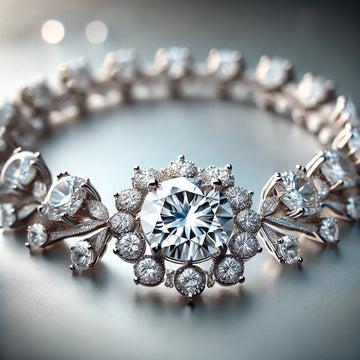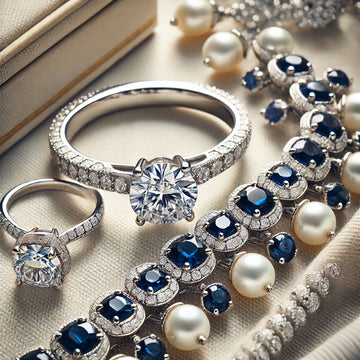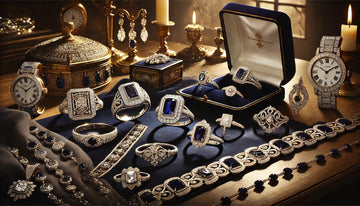Modern Trends in Fine Jewelry : From Classic to Contemporary
by Keyur Koshiya on Oct 19, 2024

Evolution of Fine Jewelry Styles
1. Ancient and Classical Periods :
- In ancient civilizations, jewelry was closely tied to religious, cultural, and political significance. Egyptians, for example, adorned themselves with gold and semi-precious stones such as turquoise, carnelian, and lapis lazuli. Gold, associated with the sun god Ra, was believed to have divine powers.
- The Greeks and Romans also contributed to the development of fine jewelry, using gemstones like garnets, amethysts, and pearls in their intricate designs. Their jewelry was a symbol of status and wealth, often depicting mythological figures and deities.
2. Medieval and Renaissance Eras :
- During the medieval period, religious jewelry such as crosses and medallions gained popularity. Jewelry was typically worn by royalty and the nobility, often as a display of power and wealth. Goldsmiths became increasingly skilled in creating detailed and ornate pieces, combining gold with precious stones.
- The Renaissance era marked a resurgence of artistic expression in jewelry. Influenced by classical antiquity, jewelry during this time became more elaborate and colorful, with an emphasis on symmetry and balance. The introduction of new gemstones and techniques, such as enamelwork, also transformed jewelry design.
3. Baroque and Rococo Styles :
- The Baroque period (17th century) saw a shift toward extravagant and bold designs, with a focus on larger, more dramatic jewelry pieces. Pearls, diamonds, and colored gemstones were set into intricate gold settings, often featuring floral or scroll motifs.
- Rococo jewelry (18th century) emphasized a lighter, more playful style with asymmetrical designs. Delicate pieces adorned with enamel, ribbons, and bows became popular, reflecting the social and cultural trends of the time.
4. Victorian Era :
- The Victorian era (1837-1901) was a time of great change, and jewelry reflected the sentimental, romantic nature of the period. Queen Victoria herself influenced many jewelry trends, especially the use of lockets, cameos, and mourning jewelry.
- Early Victorian jewelry was characterized by its intricate and ornate designs, often incorporating natural motifs such as flowers, leaves, and animals. As the era progressed, mourning jewelry became more prevalent following the death of Queen Victoria’s husband, Prince Albert, with dark materials like jet and onyx being used to create somber pieces.
5. Art Nouveau and Art Deco Movements :
- The Art Nouveau period (1890-1910) introduced a more fluid and organic aesthetic to fine jewelry, with motifs inspired by nature, such as flowers, insects, and flowing lines. The use of enameling and opals became prominent, and jewelry designers experimented with non-traditional forms and materials.
- In contrast, the Art Deco period (1920s-1930s) embraced geometric shapes, bold colors, and symmetry. Diamonds, platinum, and other precious materials were used in sleek, modern designs. Art Deco jewelry remains one of the most recognizable and sought-after styles in fine jewelry to this day.
6. Contemporary Jewelry :
- Today, fine jewelry designers continue to draw inspiration from past styles while incorporating modern techniques and materials. Minimalism, sustainability, and personalization are current trends, with many people opting for sleek, understated pieces that can be worn daily. At the same time, vintage and antique jewelry has experienced a resurgence, with many collectors seeking pieces from previous eras.
Ethical Considerations in Fine Jewelry
1. Conflict-Free Diamonds :
- Diamonds have long been associated with human rights violations, particularly in regions where "blood diamonds" or "conflict diamonds" are mined. These diamonds are mined in war zones and sold to finance armed conflict against governments.
- In response to this issue, the Kimberley Process Certification Scheme (KPCS) was established in 2003. The Kimberley Process aims to ensure that diamonds are sourced from conflict-free regions, requiring governments and companies to follow stringent procedures for diamond sourcing. However, the process has faced criticism for not being foolproof, leading many consumers to seek alternatives like lab-grown diamonds.
2. Lab-Grown Gemstones :
- Lab-grown gemstones, including diamonds, sapphires, and emeralds, offer an ethical and sustainable alternative to mined stones. These stones are created using advanced technological processes that replicate the conditions under which natural gemstones form. Lab-grown diamonds, for instance, have the same physical, chemical, and optical properties as natural diamonds but are created in a controlled environment, making them more environmentally friendly and free from ethical concerns.
- Lab-grown diamonds are gaining widespread acceptance in the fine jewelry market as a result of their lower environmental impact and transparent supply chains. They are often less expensive than mined diamonds, offering consumers more options when selecting their jewelry.
3. Fair-Trade and Responsible Mining :
- Some companies are committed to sourcing metals and gemstones through fair-trade and responsible mining practices. This involves ensuring that miners are paid fair wages, work in safe conditions, and that the environmental impact of mining is minimized.
- Fair-minded gold, for example, is certified to meet these standards, giving consumers the option to purchase gold that has been responsibly sourced. Other ethical jewelry brands may focus on recycling precious metals or reducing waste in their production processes.
4. Sustainable Jewelry Practices :
- Sustainability is becoming an important factor in the fine jewelry industry. Sustainable jewelry brands prioritize reducing their carbon footprint, using recycled materials, and minimizing waste during production.
- Many modern jewelry houses are incorporating more sustainable practices, such as using eco-friendly packaging, energy-efficient manufacturing processes, and conflict-free or lab-grown stones. This shift towards sustainability is especially important as consumers become more environmentally conscious in their purchasing decisions.
Purchasing Fine Jewelry: What to Consider
1. Understand the 4Cs of Gemstones :
- When it comes to diamonds, understanding the "4Cs" (Cut, Color, Clarity, and Carat weight) is crucial to assessing the value and quality of the stone. These same principles can often be applied to other gemstones like sapphires, rubies, and emeralds.
- Cut : Refers to how well the stone has been shaped and faceted, affecting its brilliance and light reflection.
- Color : Diamonds are graded on a scale from D (colorless) to Z (light yellow or brown). The less color a diamond has, the more valuable it is.
- Clarita : Refers to the presence of internal or external imperfections, known as inclusions and blemishes, respectively. The fewer the imperfections, the higher the clarity grade.
- Carat Weight : Refers to the size of the diamond or gemstone. Larger stones are generally more expensive, but carat weight should be considered alongside cut, color, and clarity to determine overall quality.
2. Research the Jeweler :
- Purchasing fine jewelry from a reputable jeweler is essential to ensure authenticity, quality, and craftsmanship. Established jewelers often have certifications from recognized gemological institutes such as the Gemological Institute of America (GIA) or the American Gem Society (AGS). These certifications provide assurance of the quality and authenticity of the gemstones and materials used.
- Reviews, recommendations, and past customer experiences can also provide insight into a jeweler's reputation.
3. Request Certification :
- When purchasing diamonds or other high-value gemstones, always request a certification from an independent gemological laboratory like the GIA. Certification documents provide detailed information about the stone's characteristics, including the 4Cs, which helps you verify the quality and authenticity of the stone.
- Gemstone certifications also serve as important documents for insurance and resale purposes.
4. Consider the Metal :
- The choice of metal can greatly influence the appearance and longevity of a piece of fine jewelry. While gold is the most popular choice, consider the different types (yellow, white, and rose gold) as well as platinum and silver.
- Platinum is more durable than gold and retains its color over time, making it an excellent option for settings that will hold valuable gemstones. However, it is also more expensive. Gold, on the other hand, is versatile and available in a range of colors and price points.
5. Style and Personalization :
- Fine jewelry is often a deeply personal choice, whether you're selecting an engagement ring, a special gift, or a timeless piece for yourself. When purchasing fine jewelry, consider the recipient's personal style and preferences. Some people prefer classic, understated designs, while others may opt for more unique and contemporary pieces.
- Many jewelers offer customization options, allowing you to create a one-of-a-kind piece that reflects your vision. Customization can involve selecting specific gemstones, engravings, or designing a completely original setting.
6. Budget and Investment Potential :
- Fine jewelry can be a significant financial investment, so it's important to set a budget

 Engagement Ring
Engagement Ring  Anniversary Rings
Anniversary Rings Solitaire Rings
Solitaire Rings Halo Rings
Halo Rings Men's Ring
Men's Ring Toi Moi Ring
Toi Moi Ring Three Stone Rings
Three Stone Rings Nature Inspired Rings
Nature Inspired Rings Rose Cut Diamond Rings
Rose Cut Diamond Rings Fancy Color Rings
Fancy Color Rings Antique Cut Diamond Rings
Antique Cut Diamond Rings Wedding rings
Wedding rings All Lab Grown Diamond Ring
All Lab Grown Diamond Ring Engagement Ring
Engagement Ring  Three Stone Rings
Three Stone Rings Daily Wear
Daily Wear Fancy Color Rings
Fancy Color Rings Antique Cut Diamond Rings
Antique Cut Diamond Rings Earrings
Earrings Bracelet
Bracelet Pendent
Pendent Necklace
Necklace Rings
Rings Earrings
Earrings All Rainbow Collection
All Rainbow Collection Tennis chain
Tennis chain Custom Pendent
Custom Pendent Custom Ring
Custom Ring Custom Teeth Grillz
Custom Teeth Grillz Round
Round Oval
Oval Cushion
Cushion Marquise
Marquise Pear
Pear Emerald
Emerald Heart
Heart Princess
Princess Rose Cut
Rose Cut Radiant
Radiant Antique Cut
Antique Cut Regular Cut
Regular Cut Cushion
Cushion Men's Ring
Men's Ring Bridal Sets
Bridal Sets



